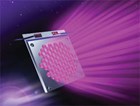Specifying LEDs: Important Performance Parameters To Consider

Click Here To Download:
•Application Note: Specifying LEDs: Important Performance Parameters To Consider
Light-emitting diodes (LEDs) are available in more wavelengths and at higher power levels than ever before, opening the door to a wider range of applications, including forensic science, biomedical, military, and security. For example, just five years ago, medium- to high-power applications such as fluorescence and photodynamic therapy were designed using gas lasers or filtered lamps. At the time, there were no ultraviolet-visible LED products available to cover the most common fluorescing dies. However, as higher optical density packages and LED arrays in the 1 to 5 watt output range become available, it is possible to use LEDs in many applications where gas lasers, filtered lamps, and other emitters were used in the past.
Unfortunately, over the entire commercial range of LEDs – from near-ultraviolet (360 nm) to nearinfrared (950 nm) – there is no consistency in defining specifications. This makes it challenging for users to compare the relative efficiencies of LEDs in the visible region to LEDs outside it. Particularly in the visible region, it is difficult for users to specify LEDs in a manner that correlates well to the system application. This article provides an overview of the important LED performance parameters, enabling users to select the product that best meets the needs of their particular application.
SOURCE: Opto Diode, An ITW Company
Click Here To Download:
•Application Note: Specifying LEDs: Important Performance Parameters To Consider
